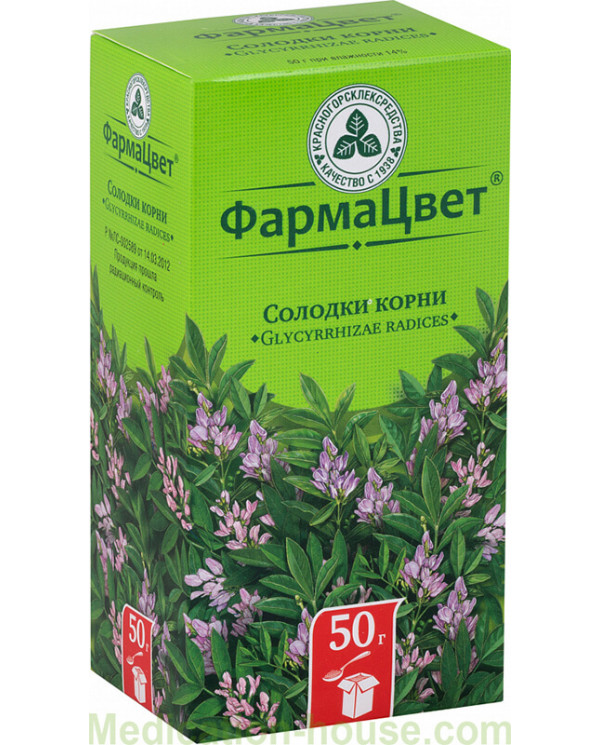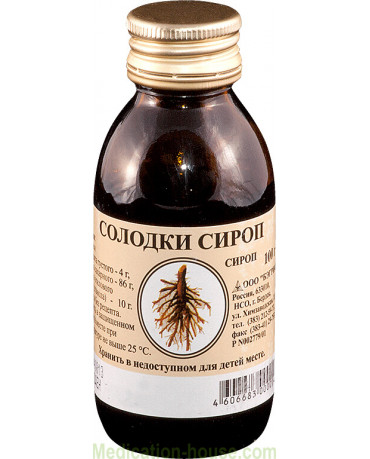Instruction for Licorice root
Reed more and buy Licorice root on this page
Licorice root is a herbal remedy. Licorice root contains glycyrrhizin (from 6 to 12%), glycyrrhizic acid and its salts, flavonoic glycosides (liquiquirithin, liquiquirithigenin, liquiquiritoside), isoflavonoids (formononetin, glabren, glabridin, glabrol, 3-hydroxyglobroloron glycerin, glycerin isoglycyrol, lycocoumarin), hydroxycoumarins (including herniarin, umbelliferone, glycocoumarin, lycopyranocoumarin), steroids (sterols, including beta-sitosterol, sigmasterol), essential oils (in small quantities).
Glycyrrhizin stimulates the activity of the ciliary epithelium and enhances the secretory function of the mucous membranes of the upper respiratory tract, facilitates expectoration. It has anti-ulcer and anti-inflammatory effect, reduces platelet aggregation.
Licorice inhibits the enzyme 11-beta-hydroxysteroid dehydrogenase in the kidneys, which leads to a decrease in the conversion of cortisol to cortisone. The mineralocorticoid activity of cortisol is due to a decrease in the concentration of potassium in the blood serum and an increase in the sodium content, which leads to fluid retention in the body, an increase in body weight and arterial hypertension. Glycyrrhizic acid and its metabolites inhibit the peripheral metabolism of cortisol and cause a pseudoaldosterone-like effect.
Likviritozid has an antispasmodic effect on smooth muscles.
Structure
Licorice roots (licorice and licorice Ural roots with underground shoots) + excipients.
Indications
diseases of the upper respiratory tract, lungs (cough with sputum with bronchitis, laryngitis, pneumonia);
hyperacid gastritis;
peptic ulcer of the stomach and duodenum;
Addison's disease;
hypofunction of the adrenal cortex (as part of complex therapy).
Side effect
increase in blood pressure;
the appearance of edema;
disorders of the reproductive system.
Contraindications
chronic hepatitis;
liver disease with cholestasis;
cirrhosis of the liver;
severe renal failure;
diabetes;
heart rhythm disturbances;
arterial hypertension;
hypokalemia;
pregnancy;
hypersensitivity to licorice.
Pregnancy and lactation
Licorice preparations are contraindicated in pregnancy.
Use in children
It is possible to use the drug in children in age dosages.
special instructions
With prolonged use, hypokalemia, hypernatremia, edema, arterial hypertension, functional disturbances of the activity of the heart are possible.
It is not used to treat dry cough, as it has an expectorant effect.
Drug interaction
The simultaneous use of licorice thiazide diuretics is not recommended because of the risk of hypokalemia.
Hypokalemia due to prolonged use of licorice can potentiate the toxic effect of cardiac glycosides.
With the simultaneous use of licorice and glucocorticosteroids (GCS), an increase in the half-life of cortisol is possible.
The medicinal properties of licorice are also used for gastritis, gastric ulcer, duodenal ulcer and other diseases of the digestive system.
Popular names: licorice, licorice.
Description: Both types of licorice are perennial herbaceous plants with erect sturdy stems 50-100 cm high. Rhizomes form a multi-tiered underground network consisting of interwoven horizontal and vertical sections. The roots penetrate to a depth of 8 m, reaching the level of groundwater. Leaves are alternate, pinnate, with point glands. Flowers are collected in loose pyramidal brushes. Moth flowers, with a whisk of pale purple. The fruit is a leathery straight or slightly curved brown bean.
Composition: licorice roots contain glycyrrhizin (potassium and calcium salt of glycyrrhizic acid), flavonoids (liquiquirithin, isoliquirithin, lacriside), ascorbic acid, essential oil, gums, resins and other biologically active substances.
Pharmacological action: licorice preparations have anti-inflammatory, expectorant, diuretic, laxative, antacid, antihistamine, diaphoretic, analgesic, restorative, antimicrobial and relaxing smooth muscle properties.
"Sweet root" (as they call licorice for sugary sweet taste) is one of the most ancient medicinal plants.
The birthplace of licorice is the Mediterranean, especially Spain, Southern France, Italy, Greece. It also grows in Russia, Iran, Syria. Pharmaceutical goods come mainly from cultural plantings: “Spanish raw materials” (from Spain, from the south of France and Italy) and “Russian raw materials” (from Turkmenistan, Iraq and China).
The roots of the plant are used to make high-quality mascara, ink and watercolors. When ore is enriched by the flotation method, milled roots are used as a blowing agent.
It is believed that licorice root contributes to the rejuvenation of the body.
Terms of sel
You don't need a prescription to buy Licorice root.


